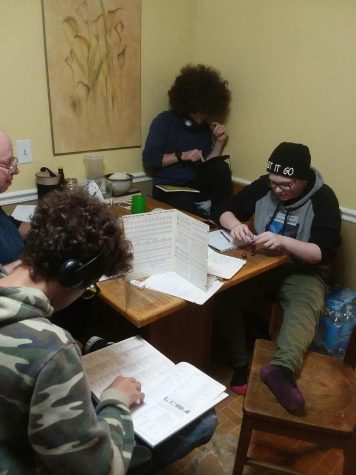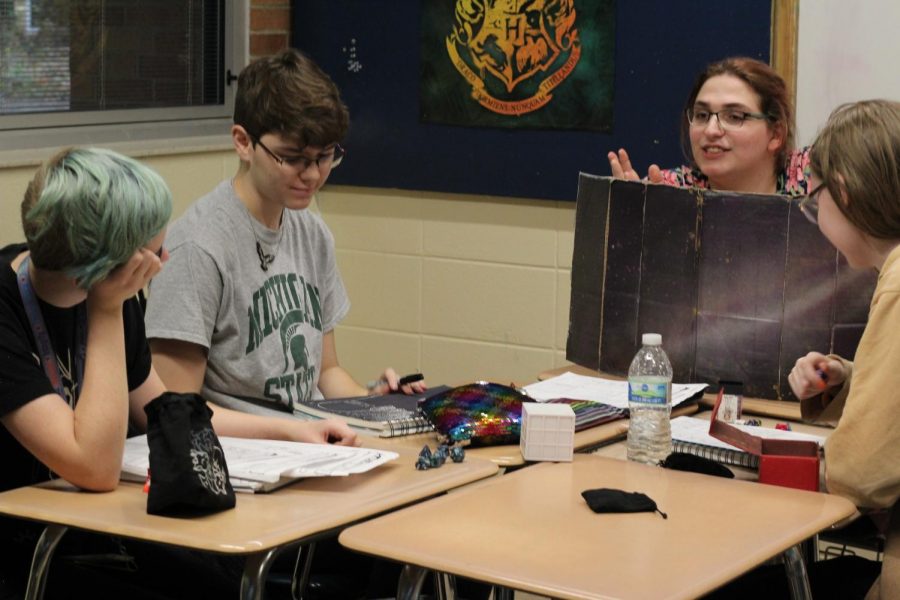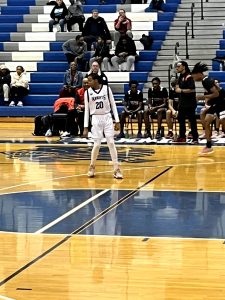“Dungeons and Dragons” is still going strong after 44 years
Credit: Maya Crawford
SWORD members Kai Neve-Jones, Asher Gilbert, and Dash DeGrote listen carefully as Dungeon Master Natalie Sweet paints the scene. (Left to right: Kai Neve-Jones, Asher Gilbert, Natalie Sweet, and Dash Degrote)
November 20, 2019
A group of students sit around a table after school, but in their minds, they’re standing in front of guarded gates in a heavy thunderstorm. The guards refuse to let them in, so one player tries to persuade them that the party is cold and weary and asks for a place to stay.
In real life, they roll a 20 sided dice, landing on 15, which is enough to convince the guards to let the group in. The guards are polite and offer the party room and board for the night, but one of the other players attempts to secretly pickpocket the guards while they are distracted. The player rolls and gets a six. The guards catch them in the act, and instead of the free room they were promised, the group hilariously spends the rest of the night in a jail cell.
This is one of the many scenes that people around the country find themselves engrossed in, and it is from a popular tabletop roleplaying game called “Dungeons and Dragons,” which was first invented by Gary Gygax and Dave Arneson in 1974, and has since released six editions.
D&D is usually played between a group of people with three or more players, called a party. The story being played out is called the campaign, and it can be as short as an hour or could take as long as a few years to play through.
Loy Norrix has a club called SWORD, Students Who Occasionally Ride Dragons. This is a D&D/Magic the Gathering club that meets every Tuesday in Latin teacher Dyami Hernandez’s room, A16. There are currently multiple campaigns in progress with many hilarious stories.
“I think my favorite story was when two players cast that synergy spell together,” said senior Joseph Ridenour, a veteran Dungeon Master (DM) of the 5th edition of the game. The DM is the storyteller/narrator of every campaign.
“Everybody kinda synergized together because you were fighting a giant slime. One person froze the slime, then [two others] cast the force wave spell in synergy and shattered it, and then [somebody else] cast the fireball because slime is flammable, and then set everything on fire. All of you did some crazy combo that just obliterated that boss that I outfitted,” said Ridenour. “I was actually kind of proud that you all worked together, and then it never happened again.”
That’s part of the appeal of “Dungeons and Dragons”. Characters are limitless as far as creation goes, and you don’t always need to get along with your team. Arguments and character conflict can make for very interesting roleplay, and may result in decisions that wildly change the original direction of the campaign.
“My favorite story was when we did a ‘beach episode’ and celebrated Candlenights, a D&D holiday,” junior Kai Neve-Jones continued. Candlenights is a winter holiday in ‘Dungeons and Dragons’, similar to Christmas. “We just sat around the campfire and gave gifts to each other’s characters, and it was wholesome and nice,” said Neve-Jones.
Loy Norrix isn’t the only place where D&D is popular, and certainly not the only place where students play. Aside from Kalamazoo Central’s club, Gaming and Giants, some kids play at Fanfare or at home with their friends and family, like junior Alex Zajac, who plays a mix of 1st and 2nd edition.
“I think my first paladin campaign was really fun,” said Zajac. A paladin is a player class in D&D that serves the Church. “We ventured into a building, and I set it on fire by accident, and didn’t put it out right away, so I lost my paladinship,” Zajac continued. “I had to convince my friend to trade a magical item with the Church, which I managed to do, so my paladin could be re-knighted as a paladin. It was fun, it was really really fun.”

Players Alex Zajac, Kevin Slack, and Salvador Hebben-Bagge consult their handbooks after Dungeon Master Scott Zajac begins an in-game fight.
Among the fun of D&D, there are some challenges. Lining up schedules and figuring out when everyone is free to play is a pain, and sometimes it can take a whole month before everyone is available. “Dungeons and Dragons” is also a very math based game, and with calculating damage and armor classes and modifiers, the flow of the story can be disrupted.
“[The hardest part] is nothing goes as expected,” said Zajac. “This is coming from being a player and a DM, you can have everything planned out right in front of you, and then all of a sudden someone does something that you don’t expect, and all of that goes out the window. You have to think on the spot.”
Ridenour agrees with Zajac. “But as a player, not metagaming is probably the hardest part,” Ridenour said. “Trying to separate you from your character, that’s the difficulty there.”
Metagaming is taking knowledge that you know but that your character does not have, and using it in the game.
“The hardest part is remembering things, like what happened last session, remembering to bring your dice and character sheet, etcetera,” said Neve-Jones. “Also having to make a choice that you wouldn’t make, but your character would.”
Despite the challenges, D&D is still a very loved game.
“It’s kinda the experience, like learning to love your character and learning to live your life through your character,” said Zajac.
“I still play D&D because it’s fun. I get to play a different personality than what I am and get to hang out with friends. What’s not to like, you know?” said Neve-Jones.
“Dungeons and Dragons” may not be the game for everyone, but for those willing to learn, it may be the most fun they’ve ever had.












